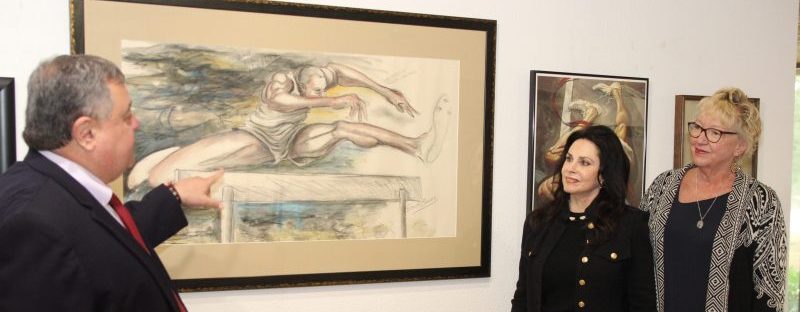United States Sports Academy Art Committee member and Trustee Susan N. McCollough and committee chair Nancy Raia viewed for the first time a selection of original, one-of-a-kind pieces by renowned sport artist Ernie Barnes on display at the American Sport Art Museum & Archives (ASAMA) on the Academy camups.
In 1984, Ernie Barnes was selected as the Academy’s first Sport Artist of the Year, following his work as the official Sport Artist for the 1984 Los Angeles Olympic Games. In 2004, Barnes was again selected as the Sport Artist of the Year, making him one of only two sport artists to receive the Academy’s prestigious award twice.
While visiting the Academy to accept his 2004 award, Barnes gave late Academy Founding President Dr. Thomas P. Rosandich an original, one-of-a-kind sketch titled “Study for Hurdlers” depicting a hurdler in action. The piece includes a hand written note and title and the artist’s signature. The piece is part of a handful of Barnes selections that were displayed in the personal collection in the home of the Academy founder until his recent death in August 2020. Four other Barnes pieces are part of the collection now on display at ASAMA.
A former professional football player, Barnes is best known for his unique figurative style of painting and is widely recognized as one of the foremost African American artists. Born Ernest Barnes, Jr. on July 15, 1938 to Ernest Sr. and Fannie Mae Geer Barnes during the Jim Crow era in Durham, North Carolina, his mother worked as a domestic for a prominent attorney. As a child, young Ernest would accompany her to work and was allowed to peruse the extensive collection of art books. One day in junior high school, a teacher found the self-admitted fat, introverted young Barnes drawing in a notebook while hiding from the bullies who taunted him daily. This teacher put him on a weightlifting program and when Barnes graduated from high school, he had excelled in football and track and field.
Segregation prevented him from considering nearby UNC or Duke University, so he attended North Carolina College on a football scholarship and majored in art. He was drafted by the then-World Champion Baltimore Colts football team. He then spent the next five seasons as an offensive lineman for the San Diego Chargers and Denver Broncos. In 1965, New York Jets owner Sonny Werblin recognized Barnes’ artistic potential and replaced his football salary for one season so he could devote himself “to just paint.” One year later, Barnes made his debut in a critically acclaimed solo exhibition at Grand Central Art Galleries in Manhattan and retired from football. His autobiography “From Pads to Palette” chronicles his transition from athlete to artist.
His sports commissions include “The Dream Unfolds,” for the NBA to commemorate their 50th anniversary; “Fastbreak” for Los Angeles Lakers owner Dr. Jerry Buss; and paintings for the owners of the Carolina Panthers, New Orleans Saints, Oakland Raiders and Boston Patriots football teams.
His neo-mannerism style of art has been admired and collected internationally. His national traveling “Beauty of the Ghetto” exhibition in the 1970s featured some of his timeless works as “Storyteller,” “High Aspirations” and “The Graduate.” His famous 1971 “Sugar Shack” dance scene appeared on the “Good Times” television show and on the Marvin Gaye album “I Want You.” This image has been widely imitated and Barnes’ expressive style has influenced countless aspiring artists.
Barnes’ art has been used as an educational tool to empower youth. The power, grace, intensity and fluidity of his work – combined with his celebrated variation of genre and sports themes – has given him an unequaled place in the history of modern art, despite the domination of abstract art throughout his career.
image sources
- Ernie Barnes – discussion: Asama.org

